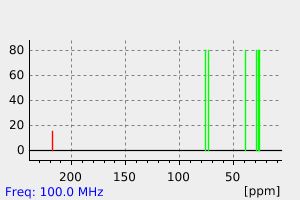oxocan-3-one | 20888-52-2
中文名称
——
中文别名
——
英文名称
oxocan-3-one
英文别名
——
CAS
20888-52-2
化学式
C7H12O2
mdl
——
分子量
128.171
InChiKey
JNDCCAGMQAHZNT-UHFFFAOYSA-N
BEILSTEIN
——
EINECS
——
-
物化性质
-
计算性质
-
ADMET
-
安全信息
-
SDS
-
制备方法与用途
-
上下游信息
-
文献信息
-
表征谱图
-
同类化合物
-
相关功能分类
-
相关结构分类
计算性质
-
辛醇/水分配系数(LogP):0.7
-
重原子数:9
-
可旋转键数:0
-
环数:1.0
-
sp3杂化的碳原子比例:0.86
-
拓扑面积:26.3
-
氢给体数:0
-
氢受体数:2
反应信息
-
作为反应物:描述:oxocan-3-one 在 selenium(IV) oxide 、 sodium acetate 、 sodium sulfate 作用下, 以 乙醇 、 氯仿 为溶剂, 生成 6,7,8,9-Tetrahydro-4H-oxocino<3,4-d><1,2,3>selenadiazol参考文献:名称:Meier, Herbert; Stavridou, Evaggelia; Roth, Silke, Chemische Berichte, 1990, vol. 123, # 6, p. 1411 - 1414摘要:DOI:
-
作为产物:描述:2-Diazo-8-hydroxy-3-oxooctansaeure-methylester 在 dirhodium tetracetate dihydrate 、 硫酸 作用下, 以 甲苯 为溶剂, 反应 2.0h, 生成 oxocan-3-one参考文献:名称:Meier, Herbert; Stavridou, Evaggelia; Roth, Silke, Chemische Berichte, 1990, vol. 123, # 6, p. 1411 - 1414摘要:DOI:
文献信息
-
Ring-enlargement reaction of alkylidenecarbenes bearing a cyclic ether or acetal group. Formation of medium-sized cyclic enol ethers or dienol ethers via bicycloalkenyloxonium ylides作者:Takashi Mori、Masahiko Taniguchi、Fumito Suzuki、Hisashi Doi、Akira OkuDOI:10.1039/a803078b日期:——The reaction of 2-acetonyltetrahydrofuran 1a and 2-acetonyltetrahydropyran 1b with the potassium salt of dimethyl diazomethylphosphonate (DAMP) in the presence of MeOH produced ring enlargement product 1-methyl-3-oxacyclooctene 6a (22%) and 1-methyl-3-oxacyclononene 6b (28%), respectively, in addition to nonrearranged products. When the side-chain was elongated by one carbon unit (1c), ring enlargement did not take place. Analogous reactions of 2-acetonyl-substituted 1,3-dioxolane 9a, 1,3-dioxane 9b and 1,3-dioxepane 9c also produced, respectively, 3,5-dimethyl-1,6-dioxacycloocta-2,4-diene (16a, 58%), a mixture (combined yield 83%) of 3,5-dimethyl-1,6-dioxacyclonona-2,4-diene (16b) and 5-exo-methylene-3-methyl-1,6-dioxacyclonon-2-ene (17b), and a mixture (combined yield 54%) of 3,5-dimethyl-1,6-dioxacyclodeca-2,4-diene (16e) and 5-exo-methylene-3-methyl-1,6-dioxacyclodec-2-ene (17e). Side-chain-elongated dioxolane 9d did not undergo enlargement and, instead, ring-switched product 3,6-dimethyl-6-[2-(tert-butyloxy)ethoxy]-5,6-dihydropyran 22 was formed. The formation of products 6, 16, 17 and 22 can be explained in terms of the intermediacy of bicyclooxonium ylides, which are formed in an intramolecular manner between the alkylidenecarbene and a cyclic ether or cyclic acetal unit. In most reactions of acetonyl-substituted cyclic acetals, the major products were di(enol ether)s 16 and 17 even in the presence of a protic nucleophile such as MeOH. A reversible intramolecular process between alkylidenecarbenes and ylides is also proposed.2-乙酰基四氢呋喃1a和2-乙酰基四氢吡喃1b与二甲基重氮甲基膦酸钾盐(DAMP)在甲醇存在下的反应分别生成了环扩张产物1-甲基-3-氧杂环辛烯6a(22%)和1-甲基-3-氧杂环壬烯6b(28%),以及未重排的产物。当侧链延长一个碳单位(1c)时,没有发生环扩张。2-乙酰基取代的1,3-二氧杂环戊烷9a、1,3-二氧杂环己烷9b和1,3-二氧杂环庚烷9c的类似反应分别生成了3,5-二甲基-1,6-二氧杂环辛-2,4-二烯(16a,58%)、3,5-二甲基-1,6-二氧杂环壬-2,4-二烯(16b)和5-外-亚甲基-3-甲基-1,6-二氧杂环壬-2-烯(17b)的混合物(总产率83%),以及3,5-二甲基-1,6-二氧杂环癸-2,4-二烯(16e)和5-外-亚甲基-3-甲基-1,6-二氧杂环癸-2-烯(17e)的混合物(总产率54%)。侧链延长的二氧杂环戊烷9d没有发生环扩张,而是生成了环转换产物3,6-二甲基-6-[2-(叔丁氧基)乙氧基]-5,6-二氢吡喃22。产物6、16、17和22的形成可以通过双环氧翁叶立德的中间体来解释,这些中间体是通过烷基亚甲基卡宾和环醚或环缩醛单元之间的分子内方式形成的。在大多数乙酰基取代的环缩醛的反应中,即使在甲醇等质子性亲核试剂存在下,主要产物也是二烯醇醚16和17。还提出了烷基亚甲基卡宾和叶立德之间的可逆分子内过程。
-
MEIER, HERBERT;STAVRIDOU, EVAGGELIA;ROTH, SILKE;MAYER, WINFRIED, CHEM. BER., 123,(1990) N, C. 1411-1414作者:MEIER, HERBERT、STAVRIDOU, EVAGGELIA、ROTH, SILKE、MAYER, WINFRIEDDOI:——日期:——
-
KOLB, M.;BARTH, J., SYNTH. COMMUN., 1981, 11, N 9, 763-767作者:KOLB, M.、BARTH, J.DOI:——日期:——
表征谱图
-
氢谱1HNMR
-
质谱MS
-
碳谱13CNMR
-
红外IR
-
拉曼Raman
-
峰位数据
-
峰位匹配
-
表征信息
同类化合物
(反式)-4-壬烯醛
(s)-2,3-二羟基丙酸甲酯
([1-(甲氧基甲基)-1H-1,2,4-三唑-5-基](苯基)甲酮)
(Z)-4-辛烯醛
(S)-氨基甲酸酯β-D-O-葡糖醛酸
(S)-3-(((2,2-二氟-1-羟基-7-(甲基磺酰基)-2,3-二氢-1H-茚满-4-基)氧基)-5-氟苄腈
(R)-氨基甲酸酯β-D-O-葡糖醛酸
(5,5-二甲基-2-(哌啶-2-基)环己烷-1,3-二酮)
(2,5-二氟苯基)-4-哌啶基-甲酮
龙胆苦苷
龙胆二糖甲乙酮氰醇(P)
龙胆二糖丙酮氰醇(P)
龙胆三糖
龙涎酮
齐罗硅酮
齐留通beta-D-葡糖苷酸
鼠李糖
黑芥子苷单钾盐
黑海棉酸钠盐
黑木金合欢素
黑曲霉三糖
黑介子苷
黄尿酸8-O-葡糖苷
麻西那霉素II
麦迪霉素
麦芽糖脎
麦芽糖基海藻糖
麦芽糖1-磷酸酯
麦芽糖
麦芽四糖醇
麦芽四糖
麦芽十糖
麦芽六糖
麦芽五糖水合物
麦芽五糖
麦芽五糖
麦芽五糖
麦芽三糖醇
麦芽三糖
麦芽三糖
麦芽三塘水合
麦芽七糖水合物
麦芽七糖
麦法朵
麦可酚酸-酰基-Β-D-葡糖苷酸
麦利查咪
麝香酮
鹤草酚
鸢尾酚酮 3-C-beta-D-吡喃葡萄糖苷
鸡矢藤苷







